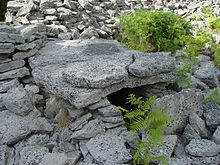Röse from Kauparve
Of the approximately 250 Rösen on the Swedish island of Gotland is Roese of Kauparve ( Swedish Kauparveröset ) one of the few scientifically researched and the only one whose rolling stone hill was completely worn away. The eroded hill belonged to the crater rose type. It had a diameter of about 23.0 m and a height of at least 2.7 m.
In 1941 the cairn was examined by Märten Stenberger (1898–1973). Stenberger exposed the outer, low (0.5 m) and an inner ring wall, preserved up to a height of 2.6 m, which was originally a little higher and enclosed a stone box made of dry masonry . Inside the hill there is a so-called crater with a diameter of eight meters, which reaches down to the ground, so that it is a ring system. The stone box contained human bones and a large spiral needle.
Another stone box of a similar construction, which lay under a mighty capstone and contained skeletal remains and parts of a bronze clasp, was uncovered in 1948 by Greta Arwidsson (1906–1998) in the southwest of the complex, partly under the inner wall. Judging by the finds, both boxes and thus the entire complex date from the older Bronze Age between 1500 and 1000 BC. Chr.
In 1967 the wheelstone grave was examined a third time, with the wheelstone packing removed entirely to show the construction of the walls and boxes. It turned out that the inner wall was older than the outer, which only served as a retaining wall for the stone filling, so that the system was renewed and considerably expanded at least once.
To the south of the Röse, four stone slabs form a box sunk into the ground, some archaeologists assume that it is a grave, others suspect that the sacrifices were laid there. A low rose northeast of the large one contained burned bones and can be dated to the younger Bronze Age (around 1000–500 BC) on the basis of some bronze fragments.
Most of the roes on Gotland are on the coast. They are listed partly from field stones, partly from limestone. The limestone built have outer walls. Larger loops probably always had a vertical or terraced circular wall on the outside. She supported the domed mounds of boulders , the top layer of selected stones existed.
See also
literature
- Mårten Stenberger : Nordic prehistory. Volume 4: Prehistory of Sweden. Wachholtz, Neumünster 1977, ISBN 3-529-01805-8 , pp. 150-152.
Web links
- Röse von Kauparve - entry in the database "Fornsök" des Riksantikvarieämbetet (Swedish)
- Description swedish + pictures
- Kauparve's rose on Grosssteingraeber.de
Coordinates: 57 ° 48 ′ 14.1 ″ N , 18 ° 48 ′ 31.7 ″ E


